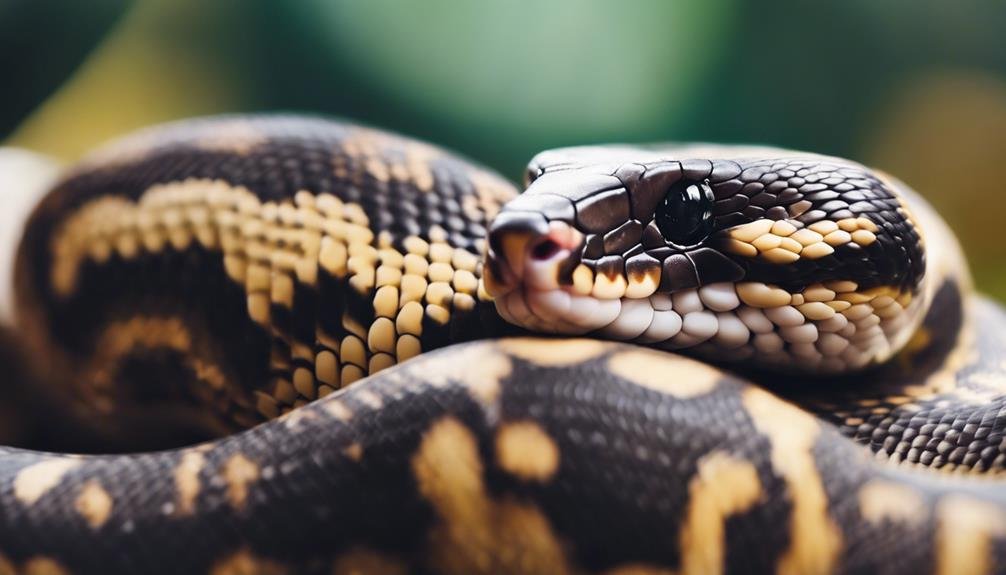You've probably noticed your ball python hissing and wondered, is it aggression or just playful banter? While hissing can often seem alarming, it's important to understand the nuances behind this behavior. Whether your slithery friend feels threatened or is merely engaging in some explorative fun, the key lies in the context and accompanying body language. Deciphering these signals can help guarantee your interactions are both safe and enjoyable. Let's explore what might be triggering these vocal expressions and how you can differentiate between a defensive stance and playful curiosity, enhancing your bond with your pet.
Key Takeaways
- Ball pythons hiss as a reaction to feeling threatened or scared, indicating discomfort or aggression.
- Defensive hissing is a warning sign, often accompanied by changes in body posture to deter predators or perceived threats.
- Playful hissing, which is softer and less intense, can occur during exploration or play, signaling curiosity rather than aggression.
- Environmental stressors, discomfort, and improper handling can trigger hissing by making the ball python feel unsafe or threatened.
- Understanding and respecting a ball python's space and body language cues are crucial to differentiate between aggressive and playful hissing.
Understanding Hissing Behavior
When your ball python hisses, it's signaling discomfort, fear, or aggression, often as a defense mechanism when feeling threatened. This behavior is a natural response, indicating that your snake isn't feeling secure in its environment. Understanding this can help you manage and address your pet's needs more effectively. It's vital to observe not just the hissing but also other body language cues and environmental factors that might be causing stress to your snake. For instance, baby ball pythons might feel more vulnerable and can frequently curl into a tight ball, along with hissing, to protect themselves.
Respecting your ball python's space is essential during these moments. If you notice your snake hissing, it's best to give it some time to calm down before attempting to handle it again. Pushing your snake too far can lead to increased stress and potential aggression. Observing and learning from these hissing cues allows you to create a safer, more comfortable environment for your ball python, reducing the occurrences of hissing due to fear or discomfort.
Defensive Vs. Playful Hissing
You might wonder about the hissing sounds your ball python makes and whether they're just playing around or feeling defensive. Recognizing the difference hinges on observing their body language and the context of the situation.
Let's explore how to tell apart defensive hissing from the rarer playful sounds, ensuring you understand your pet's behavior and mood.
Understanding Defensive Hissing
To properly care for your ball python, it's important to understand the difference between defensive hissing, a sign of discomfort or threat, and playful hissing.
When your ball python hisses defensively, it's indicating it feels threatened or uncomfortable. This type of hissing isn't about play; it's a warning. You'll often notice this hissing comes with changes in the snake's body posture, such as coiling more tightly or attempting to appear larger. These are clear signs your snake is on the defensive.
Make sure to pay attention to these cues. Ignoring defensive hissing can lead to escalation, possibly even a bite, if the snake feels further provoked. Learning and respecting these signals is important; with proper handling techniques, you can help de-escalate the situation and gradually build trust with your snake over time.
Identifying Playful Sounds
After understanding the signs of defensive hissing, it's important to recognize that not all hisses signal discomfort; some indicate your ball python is simply exploring or feeling playful. Playful hissing is typically softer and less intense than its defensive counterpart. You'll notice this during playful interactions, accompanied by behaviors like exploring, tongue flicking, and a relaxed body posture.
It's a form of communication, especially prevalent during social cues or mating rituals. When your ball python hisses playfully, it may be during playtime or when they're curious about their surroundings, expressing excitement or interest. Grasping the difference ensures you can better respond to and interact with your pet, recognizing their needs and moods.
Common Triggers for Hissing
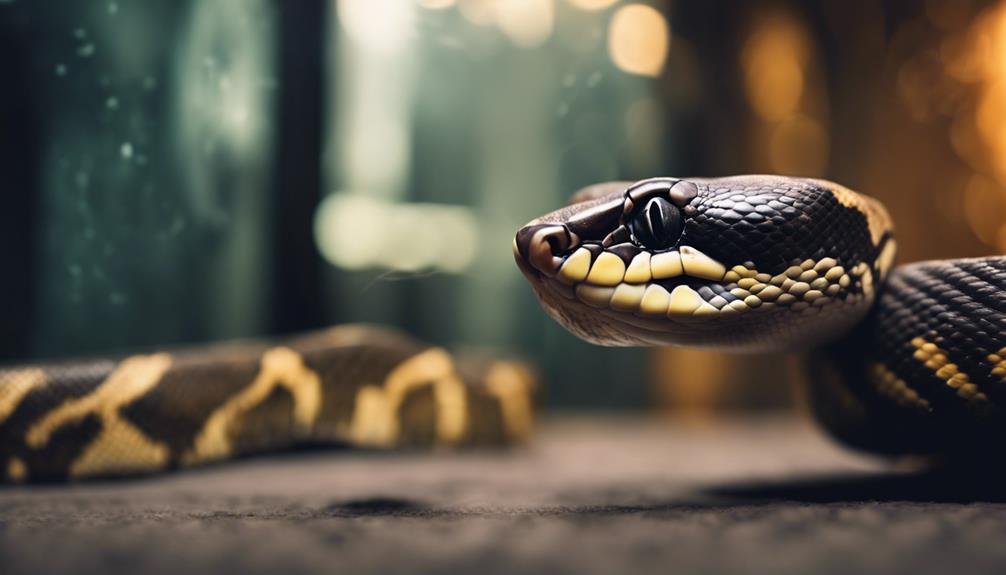

You might notice your ball python hissing if it's feeling threatened or scared.
This can be a sign of discomfort and a way for them to signal stress.
Recognizing what triggers this behavior is key to ensuring your pet feels safe and secure.
Feeling Threatened or Scared
Understanding their body language accurately is crucial in order to comprehend when they're feeling unsafe. Environmental factors play a significant role in their sense of security; abrupt movements, loud noises, or unfamiliar surroundings can make them feel cornered or vulnerable, prompting them to hiss.
Building trust with your ball python involves recognizing these signs of aggression as expressions of fear, not hostility. Implementing techniques that foster a safe and consistent environment is vital. By doing so, you'll minimize stress-induced hissing, nurturing a calmer, more trusting relationship with your snake.
Discomfort and Stress Signals
Understanding the common triggers for hissing in ball pythons, such as discomfort and stress, is essential for their well-being. When your ball python hisses, it's signaling that something's off. This behavior can stem from feeling unsafe or stressed, especially if they're lacking proper hiding spots or environmental enrichment.
Pay attention to their body language and behavioral cues. Hissing often means they perceive a threat, which can lead to defensive behavior. If they're hissing when handled, they might need more space or less frequent interactions.
The Role of Predators
Ball pythons' hissing is a key defense against predators, deterring potential threats and ensuring their survival. When you encounter a ball python in the wild, you might hear it hiss. This isn't because it's being playful or just trying to say hello. Instead, it's employing a vital survival strategy that's as effective as it's instinctual.
Hissing serves as a predator response, signaling to larger animals that it's best to think twice before considering the snake an easy meal. Here's how it works:
- Intimidation Tactic: The sudden, loud hiss can startle predators, making them reconsider their attack. It's the snake's way of saying, 'I'm bigger and more dangerous than you think.'
- Avoiding Confrontation: By hissing, ball pythons often avoid physical confrontations. It's a clear signal to back off, allowing both the snake and the predator to go their separate ways without harm.
- Essential for Survival: This behavior isn't just for show; it's an essential survival strategy in the wild. Predators may be intimidated by the hiss and choose to look for a less challenging meal elsewhere.
Territorial Displays
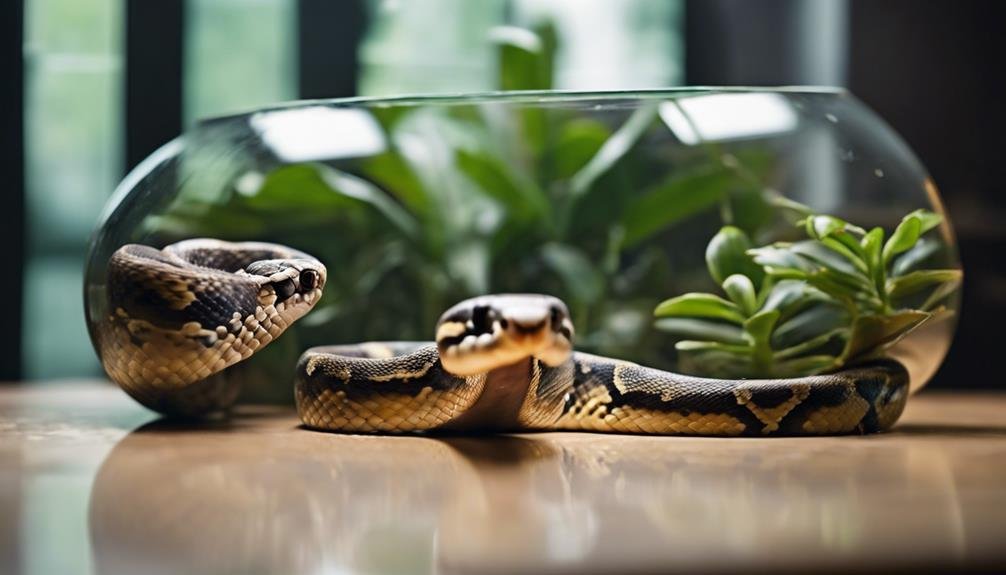

In addition to deterring predators, ball pythons also use their hiss as a powerful tool to mark territory and assert dominance. This behavior isn't just about making noise; it's an essential part of their survival strategy in the wild. When your ball python hisses, it's engaging in a form of communication that's important for its territorial displays. This isn't just random sound-making; it's a deliberate attempt to define their space and boundaries, especially when they feel their territory is being invaded.
Territorial hissing in ball pythons is a common behavior that serves as one of their dominance displays. It's a clear signal to other animals that they're entering a space that's already claimed. This form of communication is critical for their social interactions, helping to avoid unnecessary confrontations. When a ball python feels threatened in its environment, hissing becomes its way of saying, 'Back off, this is my space.'
Understanding this behavior from your ball python's perspective is essential. It's not about being aggressive without reason. Instead, it's about using communication signals to maintain their safety and comfort within their environment. Recognizing the importance of these territorial displays can help you better understand and care for your ball python.
Signs of Aggression
Recognizing the importance of territorial displays sheds light on why hissing can also be a sign of aggression in ball pythons, marking a clear warning to back off when they feel threatened. When you're dealing with these creatures, it's essential to understand the aggression indicators through their body language to guarantee both your safety and the well-being of the python.
Here are key signs to watch for:
- Hissing and Puffing Up: This is one of the most evident signs. If your ball python starts hissing or puffing itself up, it's trying to appear more intimidating as a defensive mechanism.
- Defensive Posturing: Pay attention to any changes in body posture. A ball python adopting a coiled position with its head in the center is preparing to strike. This defensive posturing is a critical warning sign.
- Tense Muscles and Heavy Breathing: These are subtler indicators of discomfort or aggression. A tense python with labored breathing is on high alert and may react defensively.
Understanding these signs is important for handling precautions and safety measures. It helps prevent potential biting incidents and ensures that interactions remain safe and stress-free for both you and your python.
Shedding and Discomfort
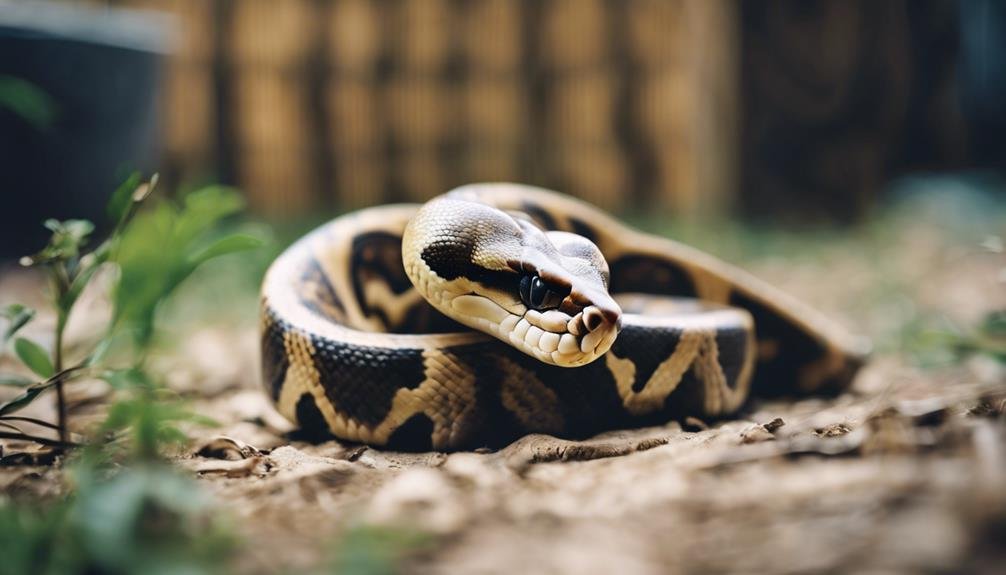

Shedding their old skin can cause significant discomfort for ball pythons, often leading to hissing as they feel vulnerable and exposed. This is an important defense mechanism, signaling their discomfort and need for safety during this period. You might notice this behavior more during shedding challenges, where the process isn't as smooth as it should be.
Proper humidity is vital in providing a comfortable shedding environment, which can greatly reduce the instances of hissing. When the old skin tightens, it not only causes physical discomfort but also intensifies their vulnerability feelings, making your ball python more likely to hiss.
Here's a quick look at how shedding and discomfort are linked to hissing in ball pythons:
| Cause of Discomfort | Result |
|---|---|
| Shedding challenges | Hissing |
| Skin tightness | Hissing |
| Vulnerability feelings | Hissing |
| Poor shedding environment | Hissing |
Understanding these triggers can help you create a more supportive environment for your pet during shedding. By addressing the root causes—like maintaining the right humidity levels—you're less likely to encounter defensive hissing, ensuring a smoother shedding process for your ball python.
Health-Related Hissing
Beyond the discomfort of shedding, hissing in ball pythons can also signal underlying health issues, such as respiratory infections or mouth rot. When your ball python starts hissing more than usual, it's important to pay attention to other signs that might indicate illness.
Respiratory infections can make breathing difficult, leading to more frequent hissing as your snake struggles for air. Similarly, mouth rot, a painful bacterial infection in the mouth, can cause your ball python discomfort, prompting it to hiss when it feels threatened or simply because it's in pain.
To make sure your ball python stays healthy and hiss-free for reasons other than its natural behavior, consider these preventive measures:
- Regular Veterinary Check-ups: Detecting illnesses early can be life-saving. Veterinary care is paramount in diagnosing and treating conditions that could lead to health-related hissing.
- Proper Husbandry Practices: Creating a clean, appropriate environment minimizes stress and the risk of infections.
- Preventive Measures Against Stress: A stress-free environment supports a healthy immune system, reducing the chance of respiratory infections and mouth rot.
Are Yawning and Hissing Natural Behaviors for Ball Pythons?
Yawning and hissing are common reasons for ball pythons to communicate and express their emotions. Yawning can indicate stress or simply be a sign of relaxation, while hissing is a defensive behavior in response to feeling threatened. Understanding these natural behaviors can help snake owners provide a suitable environment for their pets.
Reducing Hissing Incidents
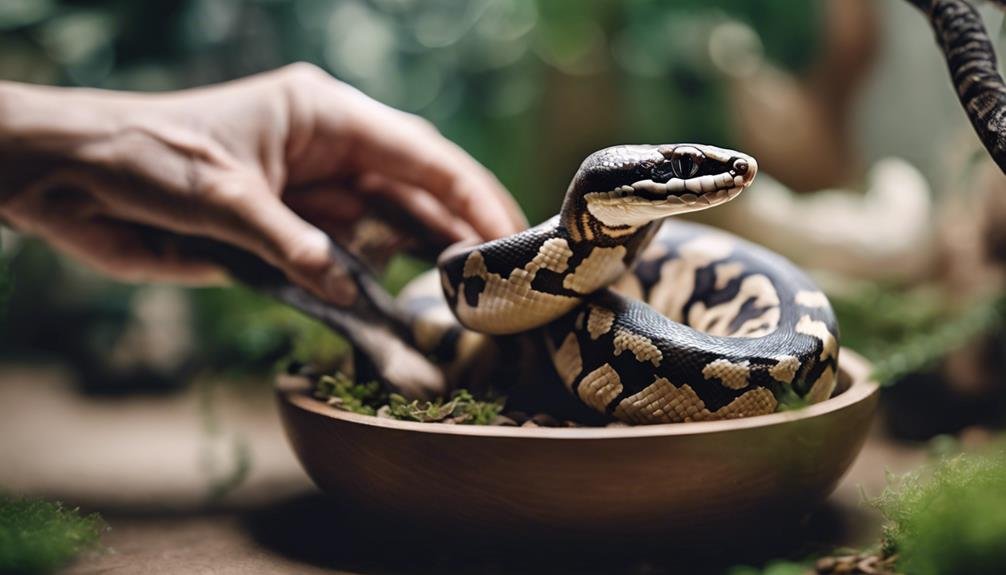

In order to reduce the frequency of hissing incidents, creating a comfortable and stress-free environment for your ball python is essential. Implementing hissing prevention techniques starts with the basics of enclosure design considerations. Make sure you provide multiple hiding spots to help your snake feel secure and reduce stress. This is a foundational step in ensuring they've a safe haven within their habitat.
Avoid handling your snake excessively, especially during sensitive times like feeding or shedding periods, as this can trigger defensive behaviors, including hissing. Instead, gradually introduce handling sessions to allow your snake to become more comfortable with you. This approach is part of effective behavioral training methods that can help minimize stress-induced reactions.
Moreover, ensuring the enclosure is properly set up with appropriate temperature, humidity, and enrichment promotes a sense of safety and security for your ball python. These elements are critical for their overall well-being and can have a significant impact on their behavior.
If the hissing behavior persists or if your snake shows signs of illness or injury, it's wise to seek advice from a reptile veterinarian. They can offer professional guidance on additional steps you can take to reduce stress and hissing in your ball python.
Conclusion
To sum up, when your ball python hisses, it's telling you something. Whether it's feeling threatened, playful, or uncomfortable, it's important to pay attention to the context and its body language.
By understanding the reasons behind the hissing, such as fear of predators, territorial issues, signs of aggression, shedding discomfort, or health concerns, you can better address your snake's needs and reduce these incidents.
Remember, patience and careful observation are key to ensuring a happy, stress-free environment for your slithery friend.

